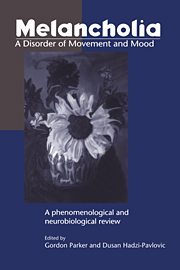Book contents
- Frontmatter
- Contents
- List of contributors
- Acknowledgments
- Introduction
- Part One Classification and Research: Historical and Theoretical Aspects
- Part Two Development and Validation of a Measure of Psychomotor Retardation as a Marker of Melancholia
- Part Three The Neurobiology of Melancholia
- 15 Melancholia as a Neurological Disorder
- 16 Melancholia and the Ageing Brain
- 17 Magnetic Resonance Imaging in Primary and Secondary Depression
- 18 Functional Neuroimaging in Affective Disorders
- 19 Summary and Conclusions
- The CORE Measure: Procedural Recommendations and Rating Guidelines
- References
- Author Index
- Subject Index
16 - Melancholia and the Ageing Brain
from Part Three - The Neurobiology of Melancholia
Published online by Cambridge University Press: 04 August 2010
- Frontmatter
- Contents
- List of contributors
- Acknowledgments
- Introduction
- Part One Classification and Research: Historical and Theoretical Aspects
- Part Two Development and Validation of a Measure of Psychomotor Retardation as a Marker of Melancholia
- Part Three The Neurobiology of Melancholia
- 15 Melancholia as a Neurological Disorder
- 16 Melancholia and the Ageing Brain
- 17 Magnetic Resonance Imaging in Primary and Secondary Depression
- 18 Functional Neuroimaging in Affective Disorders
- 19 Summary and Conclusions
- The CORE Measure: Procedural Recommendations and Rating Guidelines
- References
- Author Index
- Subject Index
Summary
Phenomenology of Depression in Older Age
If one accepts the converging evidence that some types of functional depression represent neurological disease (Rogers 1985; Starkstein and Mayberg 1993), then it stands to reason that the proportion of depressive disorders with psychomotor disturbance (PMD) should be greater with increasing age, as both cerebrovascular disease, and basal ganglia shrinkage and vacuolation appear to be linked to both PMD and growing older (Creasey and Rapoport 1985).
This hypothesis can be tested by comparing the phenomenology of depression in elderly (usually defined as at least 60 years of age) and non-elderly patients. Unfortunately, studies have produced inconsistent results. Older depressives have been described as being more anxious, preoccupied with physical symptoms, fatigued, withdrawn, retarded, apathetic, inert, uninterested in their surroundings, lacking drive (Zung 1980; Klerman 1983; Ruegg, Zisook and Swedlow 1988), hypochondriacal, anxious, self-reproachful and suicidal (American Psychiatric Association 1968; Kawashimi 1979) and as having more primary insomnia (Brown et al. 1984). However, Gurland (1976) reported that the only significant difference in the phenomenology of older depressives was their greater frequency of hypochondriacal symptoms. Blazer, Bachar and Hughes (1987) found no differences in symptoms between middleaged and elderly hospitalised melancholic depressives. Musetti et al. (1989) also argued that they had refuted the stereotype of the agitated, hypochondriacal elderly depressive, although they acknowledged that their sample was predominantly derived from outpatients.
- Type
- Chapter
- Information
- Melancholia: A Disorder of Movement and MoodA Phenomenological and Neurobiological Review, pp. 237 - 251Publisher: Cambridge University PressPrint publication year: 1996
- 3
- Cited by



